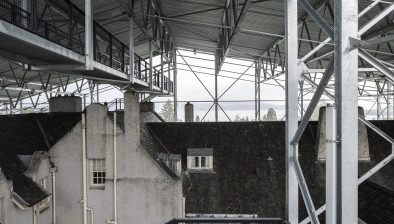National Trust for Scotland opens rescue project to save Charles Rennie Mackintosh’s Hill House
The National Trust for Scotland will this week open the doors to its most ambitious conservation project yet when the public are given access to the ‘Hill House Box’ for the first time.
Simon Skinner, chief executive officer of National Trust for Scotland, at Charles Rennie Mackintosh’s Hill House in Helensburgh
Owned by the Trust since 1982, the Hill House in Helensburgh is considered to be the finest example of domestic architecture by Charles Rennie Mackintosh. However, Mackintosh’s experimental design, combined with his trial of new materials has meant that the house has been soaking up water like a sponge for more than 115 years.
Battered by around 190 days of rain a year, the long-term survival of the building is in doubt and there is a real danger of its priceless, Mackintosh-designed interior being lost forever.
The Hill House Box is the National Trust for Scotland’s innovative solution to the problem of water damage at the Hill House and to permanently save the property and its irreplaceable collection.
Designed by architects Carmody Groarke, the Hill House Box is a vast semi-transparent shelter around the main house, consisting of a 165 tonnes steel frame swathed in chainmail made up of 32.4million rings, themselves weighing 8.3 tonnes.
Opening to the public on Friday 7 June - Charles Rennie Mackintosh’s 151st birthday - the Box acts as a giant shield covering the entire building. It will protect it from the rain while allowing the house to dry out and let conservators begin their work rescuing this iconic home.
The total cost of rescuing the Hill House will be in the region of £4.5 million. Of this, £3m is being drawn down from the National Trust for Scotland’s reserves with the remaining £1.5m coming from donations to the largest single fundraising campaign ever undertaken by the charity. In addition, the Getty Foundation made a grant of £95,000 in 2015 through its Keeping It Modern initiative towards finding a solution to the house’s problems.
Donations came from many generous benefactors as part of the Trust’s largest ever appeal, including the National Trust for Scotland USA Foundation.
It may take up to three years for the house to dry out fully before conservation work can begin in earnest. The National Trust for Scotland will then need to develop a long-lasting solution, and implement it. This means the Hill House Box may have to stay in place for between seven and ten years.
The Hill House Box’s design includes several walkways around the upper levels and over the roof. These will provide a totally new way to experience the house and Mackintosh’s design, as well as offering stunning views over the Clyde estuary.
The National Trust for Scotland has also built a new café and visitor centre, meaning even more people can experience the house and learn about Charles and Margaret Mackintosh and the Blackie family whom the house was built for.
Simon Skinner, chief executive officer of National Trust for Scotland, said: “The box is incredibly impressive in itself and being able to see the house from angles that Mackintosh could only dream of takes your breath away. But it’s more than that. We’ve completely rethought how the house and its history is presented and when people come to the Hill House they’ll see how a house like this became a home to a family.
“There are surprises at every turn and no two visits will be the same. It’s an active, evolving conservation project and there’s nothing like it anywhere else. The Hill House is an exceptional place and our approach to rescuing it is as unique as Mackintosh’s vision.
“What we’re doing at The Hill House is really what the Trust is about. We’re taking a radical approach to conservation and making sure that what we love about Scotland is here for future generations.”
Andy Groarke of architects Carmody Groarke said: “It has been an enormous privilege and education to work so closely with Hill House over the last few years. We were inspired by Mackintosh’s residential masterpiece to create a new piece of architecture which protects it from further decay, and gives visitors the chance to experience the house from unique and dramatic points of view.”
Both the interior of the Hill House itself and the Box will be accessible to the public (including disabled access) over the course of the rescue process and they will be able to watch conservators at work.




















